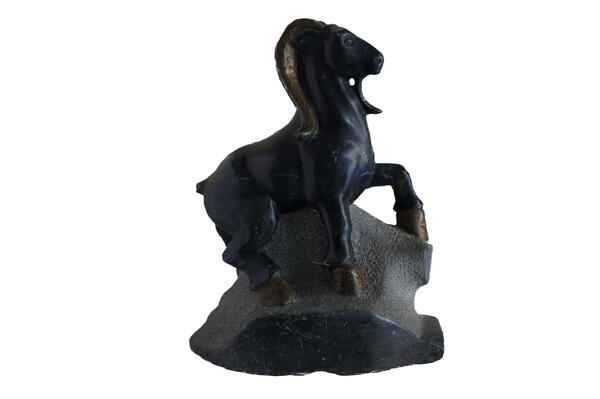Silver Hoof is the hero of Pavel Petrovich Bazhov’s tale of the same name. An old hunter, Kokovanya told his adopted granddaughter, the orphan Daryonka, a story about the magic goat. According to legend, when it stamped with his hoof, gems appeared. Kokovanya kept chasing after the fabulous goat, but it was the orphan girl who managed to get a glimpse of Silver Hoof: the miracle beast ran in front of her, scattering precious stones.
In the text of the tale, Silver Hoof is called a “goat”, but a professional hunter and forester, Kokovanya describes him as a roe deer: ”… No taller than a table, thin legs, a pretty head… his horns are excellent. Ordinary goats have two horns, and this one has five tines. In summer [the fur] is brown … and in winter it is gray.”
In the Middle Urals, hunters called the roe deer, which was the most common hoofed animal in the local forests, a “goat” or “forest goat”.
The Silver Hoof figurine was made by students of the Mramorskoye Art School. Together with a figurine of Muryonka, the cat from the same tale, and other lapidary works, it was presented to Bazhov for his 70th birthday.
Unfortunately, not all artists, sculptors, and animators who worked on illustrating the famous Ural tales were well versed in the texts. Pavel Petrovich repeatedly commented on annoying omissions, blunders, inaccuracies and errors in the visual works of his contemporaries. For example, about Konstantin Vasilyevich Kuznetsov’s illustrations for the book “The Malachite Box”, released in 1942, he wrote as follows:
In the text of the tale, Silver Hoof is called a “goat”, but a professional hunter and forester, Kokovanya describes him as a roe deer: ”… No taller than a table, thin legs, a pretty head… his horns are excellent. Ordinary goats have two horns, and this one has five tines. In summer [the fur] is brown … and in winter it is gray.”
In the Middle Urals, hunters called the roe deer, which was the most common hoofed animal in the local forests, a “goat” or “forest goat”.
The Silver Hoof figurine was made by students of the Mramorskoye Art School. Together with a figurine of Muryonka, the cat from the same tale, and other lapidary works, it was presented to Bazhov for his 70th birthday.
Unfortunately, not all artists, sculptors, and animators who worked on illustrating the famous Ural tales were well versed in the texts. Pavel Petrovich repeatedly commented on annoying omissions, blunders, inaccuracies and errors in the visual works of his contemporaries. For example, about Konstantin Vasilyevich Kuznetsov’s illustrations for the book “The Malachite Box”, released in 1942, he wrote as follows:





